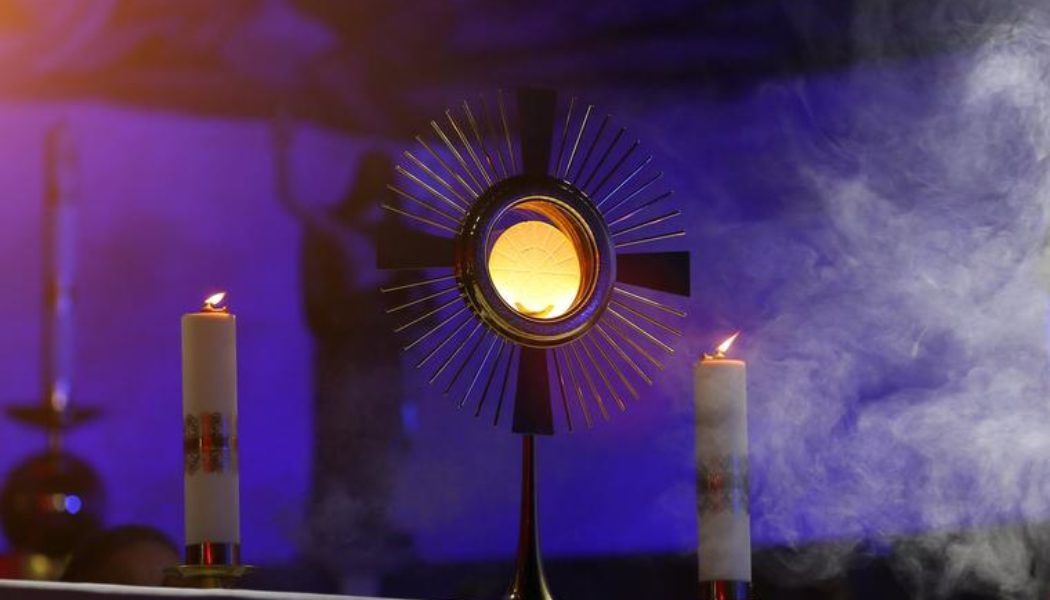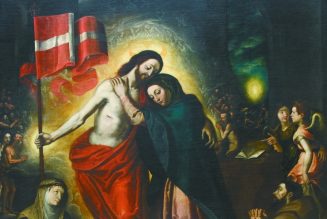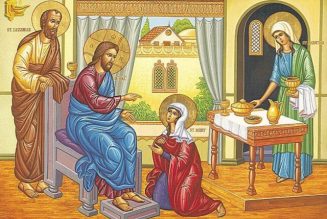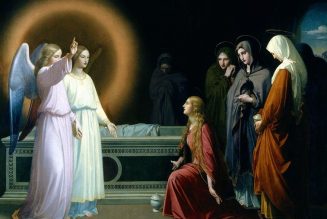
The First Sunday of Advent is ecclesiastical New Year’s Day. It is a fitting occasion to make resolutions to grow in the spiritual life, as each time we have the privilege to retrace Christ’s life in the liturgical cycle ought to be, thanks to another year’s experience, a time to align ourselves more faithfully to him whom we follow through time into eternity.
This Advent, the U.S. bishops have done us all a favor by placing before us a collective resolution: to grow in Eucharistic knowledge, faith, amazement, love, life, charity and apostolate. The three-year Eucharistic Revival the bishops have inaugurated is an opportunity to look at each of the liturgical seasons with fresh eyes and Eucharistic lenses.
Traditionally, Advent has been about preparing for the second coming of Christ through retracing the steps by which God prepared the Jewish people for his first coming. But over the last several centuries, it has also taken on the dimension of stoking our longing for Christ’s daily advent in prayer, in the sacraments and in providential diurnal occurrences. The preacher’s quip is that Advent gets us ready to hasten to meet Christ in “history, mystery and majesty,” meaning in Bethlehem, the Mass and the general judgment.
But while the Eucharistic dimension of Advent is not new, the revival is an opportunity to revitalize it, delving more deeply into the Eucharistic applications we can learn from the essential Advent virtues, figures and devotional practices. Let’s look at a few.
The basic Advent virtue is loving vigilance. We ponder the 1,300-year longing of the Jewish people for the Messiah, for the liberation and peace he would bring and for the kingdom he would inaugurate as we stoke our hunger for his coming again on the clouds of heaven or the end of our life, whichever comes first. The Church wants us to become like the wise bridesmaids in Jesus’ parable, with lamps lit waiting for the Bridegroom’s arrival (Matthew 25:1-13). It encourages us to have an Advent wreath in which, week by week, our longing, symbolized by the flame of the wreath’s four candles, grows.
This longing is meant to characterize our approach to Jesus really, substantially and truly present in the Eucharist. Many Catholics, over time, allow the fire they had toward Jesus in Holy Communion to attenuate or be extinguished. This Advent is a time to look at that love and make it practical, turning Advent hymns, familial prayers around a domestic Advent wreath and even growing darkness and decreasing temperatures into a summons to pray spiritual communions and become a living flame.
The longing of the Advent season, however, is not just on the part of believers toward God. It’s principally about God’s longing for us. Well before the people of God’s prayers and hopes were recorded in the Old Testament, indeed, even “before the foundation of the world” (Ephesians 1:4), God has been longing for us. That love led to the Incarnation, to the Passion and, ultimately, to the altar, which is a foretaste of his desire for an eternal communion.
When I prepare children to receive Jesus in Holy Communion for the first time, I ask them to ponder the intense longing the Blessed Mother, after the memory of carrying Jesus within her for nine months, would have had to receive her Son Jesus within her anew three-plus decades later in the Masses celebrated by St. Peter, St. John and the other apostles. I ask them to imagine the voracious hunger to receive Jesus of various saints they’ve come know. And I tell them that even if you take the desires of all of the saints combined, and multiply it by the biggest number one can think of, it would pale in comparison to the longing Jesus has to give himself to us. As Jesus himself said at the beginning of the Last Supper, “I have eagerly desired to eat this Passover with you before I suffer” (Luke 22:15).
Both Advent and the Holy Eucharist are about not just our desires but God’s much greater desire. Adoration of the Blessed Sacrament is a particular expression of this mutual desire.
Let’s turn to the principal Advent figures. The four traditional heralds are the prophet Isaiah, St. John the Baptist, the Blessed Virgin and St. Joseph. The Advent lessons of each are particularly helpful in augmenting our Eucharistic devotion.
So many of Isaiah’s prophecies about the Messiah are Eucharistic. He foretells a mountain banquet for all peoples of the choicest food and drink, during which the invitees will cry out, “Behold our God to whom we looked to save us” (25:6-9). He gives four “Suffering Servant” songs, pointing to Jesus’ passion when he would offer his Body and Blood to redeem us (42, 49, 50, 52-53). His vocation story, of having his lips cleansed by a seraph with fiery coal (6:1-8), was interpreted by Sts. John Chrysostom, Cyril of Alexandria and John Damascene to refer to the purifying, deifying and missionary dimensions of receiving Jesus in Holy Communion. And every day as the Word becomes flesh in the Eucharist, “Scripture is fulfilled in our hearing,” as Jesus mentioned when he applied to himself Isaiah’s messianic job description (Isaiah 61:1-2; Luke 4:21).
Similarly, St. John the Baptist’s ministry points to the Eucharist, most notably Jesus’ baptism, in which God the Father pronounces Jesus his beloved Son (Matthew 3:17) and John pronounces him, with the words we use every Mass, “the Lamb of God who takes away the sins of the world” (John 1:29).
Mary is the most Eucharistic person in all of history. St. John Paul II indicated that Jesus’ “Do this in memory of me” was an echo of her command in Cana, “Do whatever he tells you”; her fiat an anticipation of our “Amen”; her womb an image of the receptivity of our soul; her gaze holding her Son in her arms a model of the loving amazement with which we should embrace him; her suffering on Calvary an exemplary “spiritual communion of desire or oblation”; her mission in haste to Elizabeth a sign of our Eucharistic apostolate; and her Magnificat an image of our Eucharistic joy (Ecclesia de Eucharistia, 54-56).
St. Joseph shows us how not to be afraid of the mystery of taking Jesus and his mother Mary into our life. The cave in Bethlehem, the shelter in Egypt and the house in Nazareth all became sanctuaries where he learned how to live adoringly in the Real Presence of the Son of God. He shows us how to offer ourselves to Jesus in the Mass by the way he offered his body, blood, sweat, callouses, tears and all for Jesus.
Finally, we turn to Advent devotional practices. One of the most vibrant is the singing of hymns, like O Come Divine Messiah; Lo, He Comes on Clouds Descending; Come, Thou Long-Expected Jesus; and, the most famous of all, O Come, O Come Emmanuel, based on the O Antiphons the Church uses at Mass and at vespers in the Octave prior to Christmas. These all help us not only to increase our desire for Jesus but teach us about the One whom we desire and are called to relate to practically in the Eucharist as our wisdom, leader, root, key, dawn, king and God-with-us.
All of these virtues, figures and devotional practices are supposed to lead us to grasping how, on the altar, we receive the Jesus whom the shepherds, Wise Men, angels, animals and Holy Family adored, the same Jesus who will come for us anew with love.
Therefore, as we live this new liturgical year, let us resolve to make it a true year of the Lord by uniting it more consciously and practically to the Lord of history, mystery and majesty who reigns in the Eucharist and desires to revive our Eucharistic faith and thereby revitalize his Church.
Join Our Telegram Group : Salvation & Prosperity









